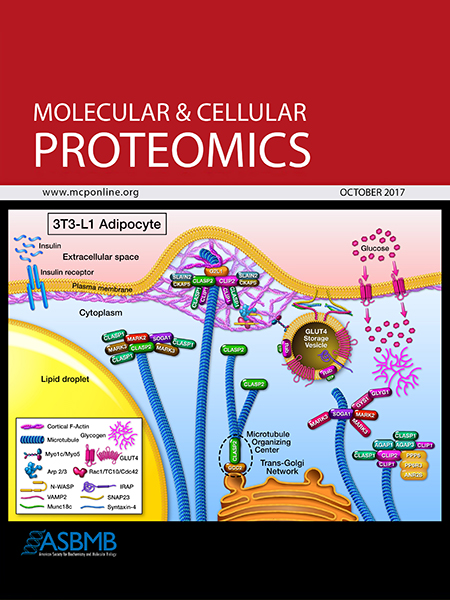 An article coauthored by University of Arizona researchers in the UA Division of Endocrinology, Diabetes and Metabolism and affiliated with the UA Health Sciences Center for Disparities in Diabetes, Obesity and Metabolism, has made the cover of the journal Molecular & Cellular Proteomics.
An article coauthored by University of Arizona researchers in the UA Division of Endocrinology, Diabetes and Metabolism and affiliated with the UA Health Sciences Center for Disparities in Diabetes, Obesity and Metabolism, has made the cover of the journal Molecular & Cellular Proteomics.
The cover image—representing about six years of research—was drawn from the article, “Characterization of the CLASP2 Protein Interaction Network Identifies SOGA1 as a Microtubule-Associated Protein.”
 Paul Langlais, PhD, an associate professor of medicine in the division and director of the new UA Department of Medicine Quantitative Proteomics Laboratory affiliated with the division and center, is the article’s lead author and developer of the graphic used for the cover.
Paul Langlais, PhD, an associate professor of medicine in the division and director of the new UA Department of Medicine Quantitative Proteomics Laboratory affiliated with the division and center, is the article’s lead author and developer of the graphic used for the cover.
Dr. Langlais joined the UA faculty in October 2016 and launched the lab in the following three months. Before coming to the UA, he was director of the Proteomics Lab and an assistant professor of biochemistry and molecular biology in the Research Division at Mayo Clinic – Scottsdale.
He earned his bachelor’s degree in biology from Texas Tech University in Lubbock, Texas, and a doctorate in biochemistry from the University of Texas Health Sciences Center at San Antonio, before completing post-doctoral research fellowships there and at ASU.
“Dr. Langlais has brought a new focus on quantitative proteomics-based analysis to the UA. His work shows the power of these approaches in experiments designed to advance our knowledge of the basic mechanisms responsible for insulin resistance, the primary characteristic of patients with type 2 diabetes mellitus who now comprise at least 10 percent of our population,”  said Lawrence J. Mandarino, PhD, the UA endocrinology division chief and center director.
said Lawrence J. Mandarino, PhD, the UA endocrinology division chief and center director.
Dr. Mandarino is a co-author along with UA’s James Krantz, Natalie Barker, Ruslan Rafikov, PhD, and Moulun Luo, PhD, as well as others from the University of Southern Denmark and ASU.
The Langlais lab researches the role of microtubule-associated proteins in insulin action, particularly the protein CLASP2. The original purpose of this work was to identify proteins associated with CLASP2 in order to understand how insulin controls glucose uptake by cells. These experiments led to the discovery of a new series of protein networks and identified new biology that may have broader disease implications.
“Dr. Langlais is highly collaborative and is ready to assist all of our faculty in the new Proteomics Laboratory that he directs in Endocrinology and the Center for Disparities in Diabetes, Obesity and Metabolism. The mission of this lab is to help UA investigators perform quantitative proteomics projects aimed at better understanding the biological problems they are studying,” Dr. Mandarino added.
Proteomics—a complement to genetic and genomic studies—involves the study of proteins, the control of their function, and mechanisms regulating their expression within cells affected by disease. Discoveries from these types of studies can shed light on why diseases occur and create potential targets for drug intervention.

